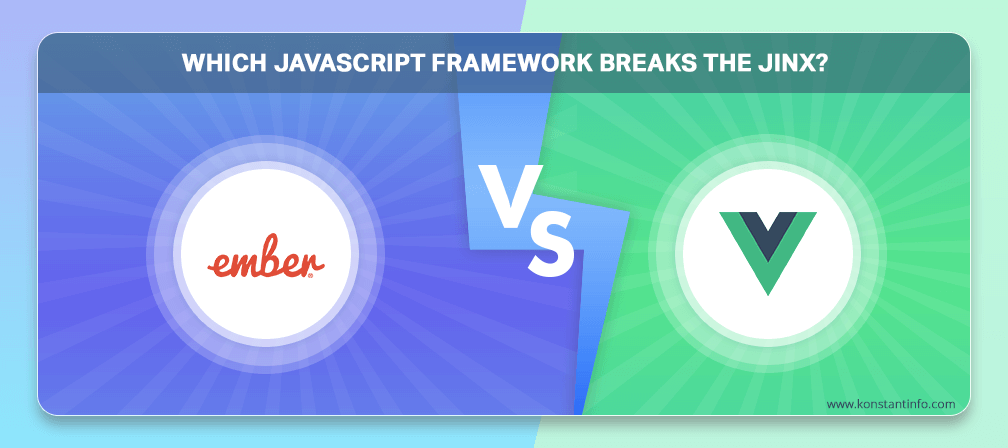
Table of Contents
Every once in a while, a new technology, an old problem and a big idea turn into an innovation. Vue.js turns out a winner as it has a comparatively steep learning curve as compared to other frameworks. It is a progressive JavaScript Framework that adds interactivity to the website. Adding a view to a single ‘div’, Vue.js takes some ideas from all modern JS frameworks. It comes with some optional tools to build user-interfaces and thus solves the hard problems of single-page apps incrementally. This is a strand in the narrative that one technology builds about oneself.
The most important reasons for which people select a particular JavaScript Framework or when they are looking for the best client-side JavaScript MV* frameworks:
With clearest official documentation, the smallest codebase, integrates well with Bootstrap and learning that it was backed by strong projects like Laravel and a big company like Alibaba, getting started with Vue.JS is easier and helpful in enhancing legacy applications with no build process whatsoever:
Ember.js on the other hand is still an immensely competent framework and almost anything can be achieved with it. Ember.js helps build the products instead of constantly configuring the stuff. Fast forward to today though Ember-CLI has 95k weekly downloads, up from 75k a year ago. Sounds good? Hold in place – Vue has 330k weekly downloads!
It can be discerned that Ember’s magic has dimmed, big time, compared to its other JS framework counterparts. Let’s formalize our curiosity by sneaking at the comparison below:
Decision Point | Vue.js | Ember.js |
|---|---|---|
| Stability | Yes | Not as good as Vue.js. |
| Community Support | Yes it has vast community support, is backed by Laravel and Alibaba | The smaller community as compared to Vue.js |
| Documentation | It has enormous tutorials and updated documentation. | An extensive amount of outdated tutorials on the web. |
| Learnability | It’s easy to learn. | It is difficult to learn. |
| Integrating with Bootstrap | Yes | |
| Code-Base | It is lightweight. It’s too big for small projects. | It is a heavyweight. It’s suitable for both single page and big applications. |
| Coding Speed | Fast | |
| Reactivity | Yes, Vue provides reactivity on plain JavasCript objects and fully automated computed properties. | No, everything needs to be wrapped in Ember objects and dependencies have to be declared by making use of computed properties. |
| Component-Based | Components are reusable Vue instances with a name. These components can be used as a custom element inside a root Vue instance. Template syntax of Vue.js is capable of harnessing the complete power of JavaScript expressions, including handlebars’ expression and helper syntax. | Components in Ember.js are used to turn markup text and styles into reusable content. It consists of two parts: A JavaScript component file and Handlebars template. |
| Performance | Vue.js outperforms Ember.js and batches updates automatically. | With Ember.js one needs to manually manage run loops in performance-critical situations. Even after its latest Glimmer engine update in Ember 3.x. |
| Tools to speed up development (Save time and deliver faster to production) | Ember comes with its own debugging tool – Ember inspector | Vue.js comes with Bit, StoryBook, Vue dev, Vue Loader, Vue-CLI, Vue templates, and boilerplates. |
| Routing | Vue router library can be used for single-page applications. | Routing is the central part of Ember applications. It enables developers to drive the application state from the URL. |
| Data Layer | Axios can be used to display data from an API. | Ember communicates with external API’s and manages application state consistently. |
One needs to decide what they really want to do – whether they want to create a single page application or just an application? Is it just a presentation layer that is required or a complete structure of the view, models, and controllers? Comparing Ember vs. Vue, if an app is required then a framework like Ember.js is suitable. Another way round, if a website is required, Vue.js is preferable.
After working with React.js for 5 years and with Angular.js for 8 years, Vue.js comes as a fresh respite that actuates things swiftly. Knowing JavaScript is undoubtedly a huge advantage but the Vue framework itself has some lucrative features to show things faster on screen.
See also: AngularJS vs NodeJS vs ReactJS: Which One Would You Choose?
Vue.js is a fast and responsive framework for designing the website front-end. It is lightweight, clean, data-driven and reactive front-end ViewModel can assist in swift development. Vue.JS takes the center-stage as it provides minimal functionality. But of course, they provide officially well-maintained tools and docs.
In this way, there are lots of things to think about and this is in no way a comprehensive list. There is a requirement to know more depending upon the constraints upon which a vuejs developer works and considers other qualities such as download size or rendering performance. But we hope that this list serves as a decent introduction to the basic issues worth thinking about. We take responsibility to set benchmarks, develop expertise in today’s transformational technologies and learn how the web application development technologies can specifically help your organization grow. Need help? Drop us a query and our team will reply as soon as they can!
Powerful add-ons, Convention over configuration, Built-in Best Practices, Integrates With Large Teams, Coherent Dev Tooling, Amazing Features, Giant Ecosystem, Stability Without Stagnation
Square, Bustle, TED, Netflix, Heroku, Microsoft, LinkedIn, skylight, Blue Apron, Intercom, Living Social, Zendesk, Groupon, CrowdStrike
The essential features like routing and data management are covered by official libraries, Fast rendering ensured by virtual DOM and minimal load time, Flexibility, Handy conventions, Developer-friendly, Performant and size-efficient, Progressive
Facebook, Netflix, Grammarly, Laracasts, GitLab, Codeship, Livestorm, Behance, Adobe, Xiaomi, Alibaba, WizzAir, EuroNews



Manish Jain is the co-founder and Managing Director at Konstant Infosolutions. He is responsible for the overall operations of the company and has played a major role in bringing Konstant up from its humble beginnings and, with his immense energy and drive, transforming it into a globally trusted name in IT solutions.
Or send us an email at: [email protected]